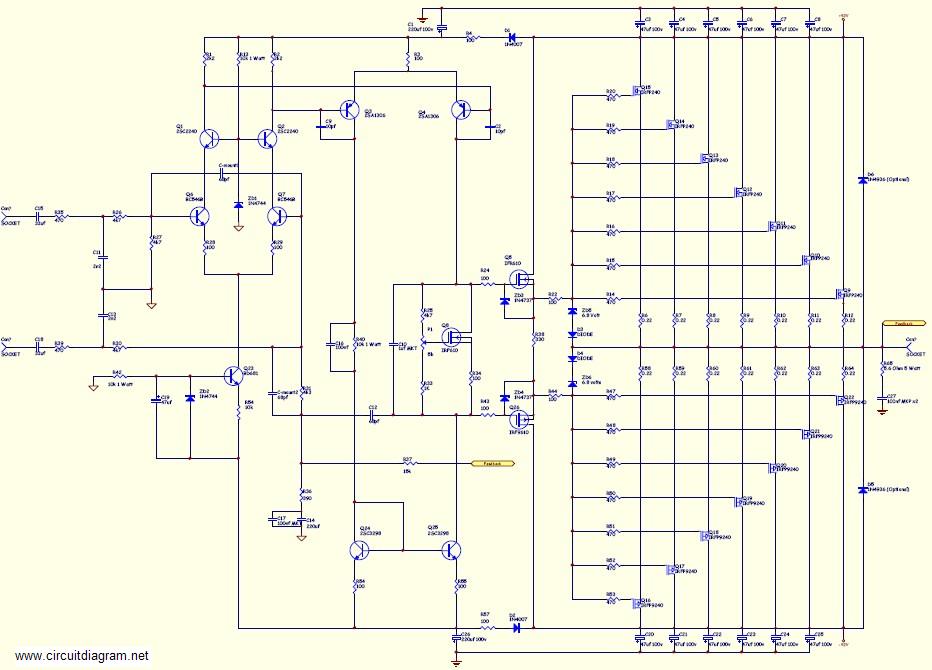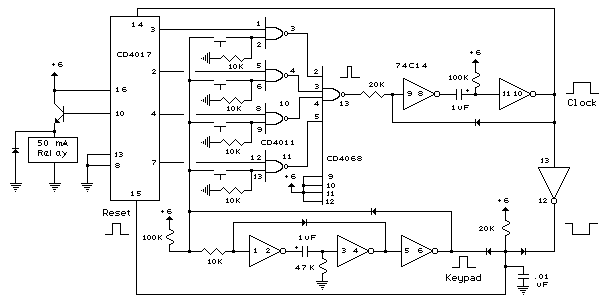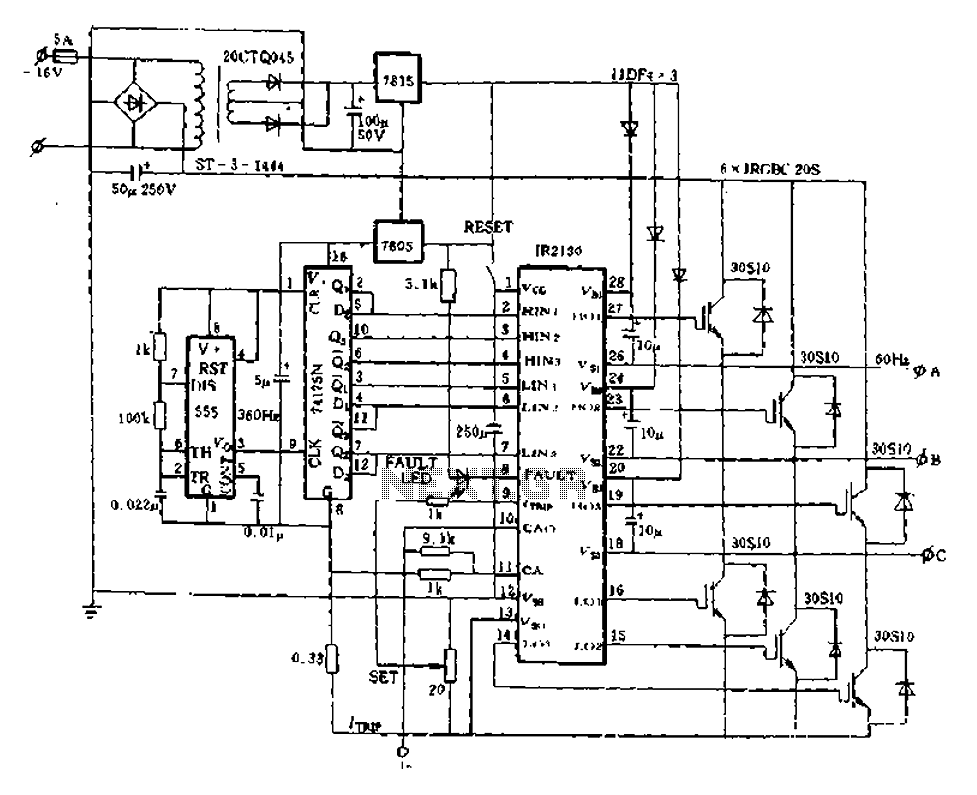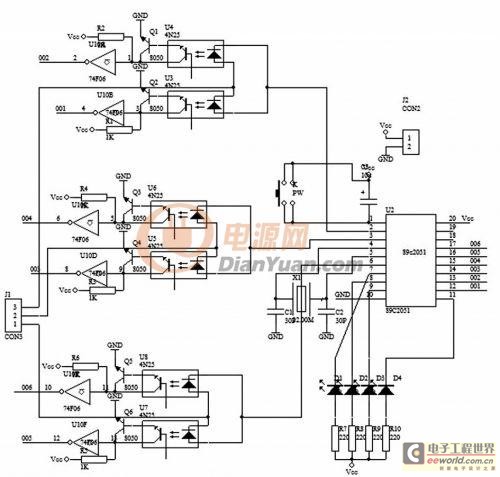
power supply schematic

An electronic rectification circuit that avoids the use of large, heavy, and expensive electrolytic capacitors by utilizing an active transistor in a gyrator configuration. To minimize excess ripple output on a power supply feeding a heavy load, a large value capacitor is typically selected following the rectifier. In this circuit, the value of capacitor C1 is only 470µF. The gyrator circuit operates on the principle that the input capacitance at the base-emitter terminals of a transistor is effectively multiplied by the static forward current gain (HFE) of the transistor. In this setup, capacitor C2, which is 100µF, is effectively enhanced at the output (Vreg). Assuming a direct current gain (HFE) of 50 for the 2N3055 power transistor, the effective value of the smoothing capacitor would be 50 times this value, equivalent to a 5000µF capacitor without the power transistor. The load draws nearly 400mA, and with the output directly from the rectifier, there is about 5V peak-to-peak ripple in the output. By using the output at the emitter of the transistor, the performance improves significantly. The circuit stabilizes the output voltage and reaches its maximum value within a few hundred milliseconds. The advantages of this design include the ability to use a smaller, less expensive reservoir capacitor while still achieving high-quality output.
The electronic rectification circuit described employs a gyrator configuration to enhance the effectiveness of the smoothing capacitors. The primary objective of this design is to eliminate the need for large electrolytic capacitors, which are often cumbersome and costly. Instead, the circuit leverages the properties of a transistor, specifically the 2N3055, to amplify the effective capacitance seen at the output.
In this configuration, capacitor C1 serves as the input capacitor, rated at 470µF, which is relatively small compared to traditional designs. The gyrator's functionality is rooted in the transistor's current gain (HFE), which allows the effective capacitance at the output to be significantly increased. For example, with an HFE of 50, the effective capacitance provided at the output is equivalent to a 5000µF capacitor, thus greatly improving the circuit's performance in terms of ripple reduction.
Capacitor C2, rated at 100µF, plays a crucial role in this enhancement. The circuit's output voltage (Vreg) experiences reduced ripple, improving the overall stability and reliability of the power supply. The load, drawing approximately 400mA, experiences a notable reduction in ripple voltage when the output is taken from the emitter of the transistor, compared to the direct output from the rectifier.
The transient response of the circuit is also noteworthy, as it stabilizes within a few hundred milliseconds after a load is applied. This quick stabilization is essential for applications where consistent voltage levels are crucial. The design's efficiency in using smaller capacitors not only reduces costs but also optimizes space in electronic assemblies, making it an attractive choice for modern electronic power supply designs.An electronic recitification circuit. The use of large, heavy and expensive electrolytic capacitors is avoided, being replaced by an active transistor in this gyrator circuit. To avoid excess ripple output on a power supply feeding a heavy load, usually a large value capacitor is chosen following the rectifier.
In this circuit, C1`s value is only a 470uF. The gyrator circuit works on the principle that the value of input capacitance at the base-emitter terminals of a transitor is effectively multiplied by the static forward current gain, HFE of the transistor. In this circuit C2, a 100uF capacitor is effectively magnified at the ouput ( Vreg ). If you assume a dc current gain, HFE of 50 for the 2N3055 power transistor, then the effective value of the smoothing capacitor would be 50x this value; or be the same as using a 5000uF capacitor without the power transistor.
The graph below shows the output voltage and current through the load :- The load draws nearly 400mA. With the output directly from the rectifier there is about 5v pk-pk ripple in the output. Using the output at the emitter of the transistor things are much better. The circuit will take a few hundred milliseconds for the output voltage to stabilize and reach maximum value.
The advantages are that a smaller, less costly reservoir capacitor can be used with this circuit to give a high quality 🔗 External reference
The electronic rectification circuit described employs a gyrator configuration to enhance the effectiveness of the smoothing capacitors. The primary objective of this design is to eliminate the need for large electrolytic capacitors, which are often cumbersome and costly. Instead, the circuit leverages the properties of a transistor, specifically the 2N3055, to amplify the effective capacitance seen at the output.
In this configuration, capacitor C1 serves as the input capacitor, rated at 470µF, which is relatively small compared to traditional designs. The gyrator's functionality is rooted in the transistor's current gain (HFE), which allows the effective capacitance at the output to be significantly increased. For example, with an HFE of 50, the effective capacitance provided at the output is equivalent to a 5000µF capacitor, thus greatly improving the circuit's performance in terms of ripple reduction.
Capacitor C2, rated at 100µF, plays a crucial role in this enhancement. The circuit's output voltage (Vreg) experiences reduced ripple, improving the overall stability and reliability of the power supply. The load, drawing approximately 400mA, experiences a notable reduction in ripple voltage when the output is taken from the emitter of the transistor, compared to the direct output from the rectifier.
The transient response of the circuit is also noteworthy, as it stabilizes within a few hundred milliseconds after a load is applied. This quick stabilization is essential for applications where consistent voltage levels are crucial. The design's efficiency in using smaller capacitors not only reduces costs but also optimizes space in electronic assemblies, making it an attractive choice for modern electronic power supply designs.An electronic recitification circuit. The use of large, heavy and expensive electrolytic capacitors is avoided, being replaced by an active transistor in this gyrator circuit. To avoid excess ripple output on a power supply feeding a heavy load, usually a large value capacitor is chosen following the rectifier.
In this circuit, C1`s value is only a 470uF. The gyrator circuit works on the principle that the value of input capacitance at the base-emitter terminals of a transitor is effectively multiplied by the static forward current gain, HFE of the transistor. In this circuit C2, a 100uF capacitor is effectively magnified at the ouput ( Vreg ). If you assume a dc current gain, HFE of 50 for the 2N3055 power transistor, then the effective value of the smoothing capacitor would be 50x this value; or be the same as using a 5000uF capacitor without the power transistor.
The graph below shows the output voltage and current through the load :- The load draws nearly 400mA. With the output directly from the rectifier there is about 5v pk-pk ripple in the output. Using the output at the emitter of the transistor things are much better. The circuit will take a few hundred milliseconds for the output voltage to stabilize and reach maximum value.
The advantages are that a smaller, less costly reservoir capacitor can be used with this circuit to give a high quality 🔗 External reference





